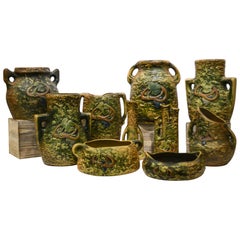Roseville Imperial
Recent Sales
Early 20th Century American Arts and Crafts Planters, Cachepots and Jard...
Ceramic
Roseville Pottery for sale on 1stDibs
Along with Stickley furniture and the copper lamps of Dirk van Erp, the works of the Roseville Pottery Company are treasured staples of the American Arts and Crafts movement. The straightforward naturalism of vintage Roseville bowls, vases, dishes and other ceramics represent a frank, American aesthetic distinct from the more stylized European Art Nouveau works of the same period. Roseville Pottery works are the essence of honest artisanry.
Founded in Roseville, Ohio, in 1890, the company originally focused on flowerpots, mixing bowls, and other household items, but branched out into art pottery in 1900. An early manifestation of the Arts and Crafts movement in the United States — which celebrated traditional craftsmanship and would influence designers and architects including Frank Lloyd Wright — was Fulper, Rookwood and Roseville pottery. Hand-painted florals and gourd-like shapes were the pieces’ most obvious characteristics.
Roseville pottery typically features decorative motifs inspired by nature — the company’s Pinecone and Blackberry patterns are perennial favorites among collectors — and glazes in warm, earthy shades of brown and gold.
Roseville's Pinecone pattern was the brainchild of art director Frank Ferrell, who sculpted the prototype for each piece by hand. His most successful ideas went into mass production, while others were limited to only a few experimental pieces. These “experimentals” are now the most sought-after Roseville wares — look for the official Roseville pottery marks on the bottom or side of a piece, along with a number or (in some cases) even a note.
As you will see from the items on these pages, Roseville Pottery produced ceramics of timeless and enduring warmth and beauty. They merit a place in every collection of American design.
Find vintage Roseville bowls, vessels and other works for sale on 1stDibs.
A Close Look at arts-and-crafts Furniture
Emerging in reaction to industrialization and mass production, the Arts and Crafts movement celebrated handcrafted design as a part of daily life. The history of Arts and Crafts furniture has roots in 1860s England with an emphasis on natural motifs and simple flourishes like mosaics and carvings. This work is characterized by plain construction that showcases the hand of the artisan.
The earliest American Arts and Crafts furniture dates back to the start of the 20th century. Designers working in this style in the United States initially looked to ideas put forth by The Craftsman, a magazine published by Wisconsin native Gustav Stickley, a furniture maker and founder of the Craftsman style. Stickley’s furniture was practical and largely free of ornament. His Craftsman style drew on French Art Nouveau as well as the work he encountered on his travels in England. There, the leading designers of the Arts and Crafts movement included William Morris, who revived historical techniques such as embroidery and printed fabrics in his furnishings, and Charles Voysey, whose minimal approach was in contrast to the ornamentation favored in the Victorian era.
American Arts and Crafts work would come to involve a range of influences unified by an elevation of traditional craftsmanship. The furniture was often built from sturdy woods like oak and mahogany while featuring details such as inlaid metal, tooled leather and ceramic tiles. The style in the United States was led by Stickley, whose clean-lined chairs and benches showcased the grain of the wood, and furniture maker Charles Rohlfs, who was informed by international influences like East Asian and French Art Nouveau design.
Hubs in America included several utopian communities such as Rose Valley in Pennsylvania and the Byrdcliffe Arts and Crafts Colony in New York, where craftspeople made furniture that prioritized function over any decoration. Their work would influence designers and architects including Frank Lloyd Wright, who built some of the most elegant and iconic structures in the United States and likewise embraced a thoughtful use of materials in his furniture.
Find antique Arts and Crafts chairs, tables, cabinets and other authentic period furniture on 1stDibs.
Finding the Right planters-jardinieres for You
Beautiful plants deserve beautiful homes. It’s time to introduce antique and vintage planters and jardinieres to your home’s interiors and outdoor garden area.
The word “jardiniere” has roots in French, but the appeal of these vessels is global. The popularity of jardinieres — ceramic pots intended for cut flowers or plants — quickly gained traction in the United States during the start of the 20th century, when you could find them in some middle- and upper-class American homes. Jardinieres had already been coveted goods overseas for at least a couple of centuries by then, as intricate planters crafted from Chinese porcelain or gilded-bronze versions from Japan could be found in the living rooms of wealthy Europeans.
Today, the love for planters and jardinieres knows no bounds. And whether you consider yourself a proper gardener or merely a doting plant parent, there is likely a use for a planter inside or in the lively outdoor space around your home.
Outside, a pair of marble and terracotta planters or cast-iron urns designed in the neoclassical style can add a stately touch to your landscape design while helping establish boundaries between the areas you’ve created for gardening and entertaining.
Bare corners in your living room or dining room can often be difficult to populate with furnishings that fit just so, and a planter can change that. While it’s possible to get maximal impact from minimalist pottery — an understated mid-century modern planter could deliver on that front — you might be pining for an on-trend planter with pizzazz. Look to an outwardly angular fiberglass design decked out in bright colors to give your blooms a run for their money, while mounted or vintage hanging vessels can serve as the frame for nature’s organic artwork, quite literally taking your gardening skills to the next level.
Browse a broad collection of antique and vintage planters and jardinieres on 1stDibs today.
